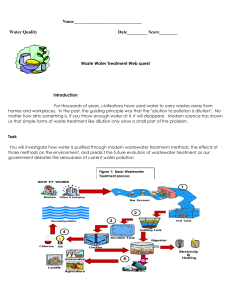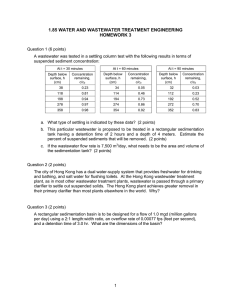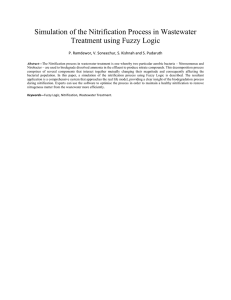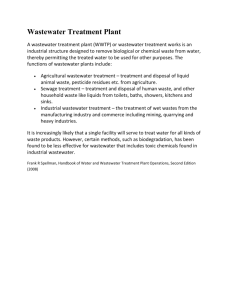Wastewater Treatment Webquest: AP Environmental Science
advertisement
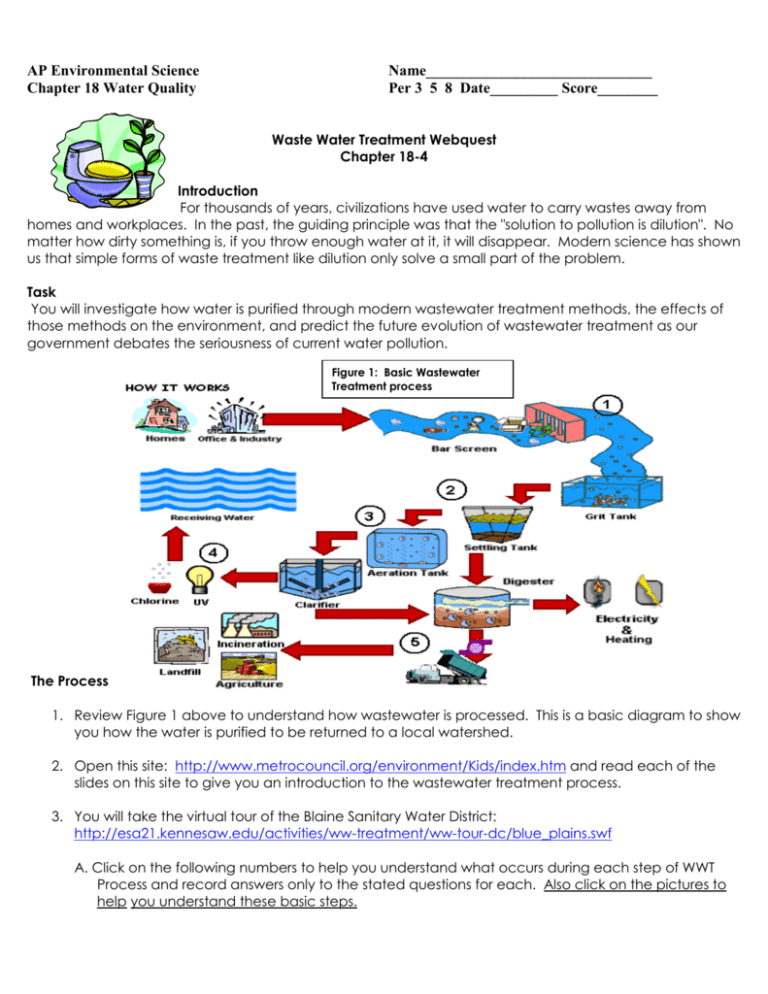
AP Environmental Science Chapter 18 Water Quality Name______________________________ Per 3 5 8 Date_________ Score________ Waste Water Treatment Webquest Chapter 18-4 Introduction For thousands of years, civilizations have used water to carry wastes away from homes and workplaces. In the past, the guiding principle was that the "solution to pollution is dilution". No matter how dirty something is, if you throw enough water at it, it will disappear. Modern science has shown us that simple forms of waste treatment like dilution only solve a small part of the problem. Task You will investigate how water is purified through modern wastewater treatment methods, the effects of those methods on the environment, and predict the future evolution of wastewater treatment as our government debates the seriousness of current water pollution. Figure 1: Basic Wastewater Treatment process The Process 1. Review Figure 1 above to understand how wastewater is processed. This is a basic diagram to show you how the water is purified to be returned to a local watershed. 2. Open this site: http://www.metrocouncil.org/environment/Kids/index.htm and read each of the slides on this site to give you an introduction to the wastewater treatment process. 3. You will take the virtual tour of the Blaine Sanitary Water District: http://esa21.kennesaw.edu/activities/ww-treatment/ww-tour-dc/blue_plains.swf A. Click on the following numbers to help you understand what occurs during each step of WWT Process and record answers only to the stated questions for each. Also click on the pictures to help you understand these basic steps. #1 Debris and Gut Removal BuildingA. What happens here? #2 Primary Sediment Building A. What is meant by sedimentation? B. Why are salts added to the water? #3 Secondary Reactors Building A. Click on the third image – What is added to the water and why? #4 Secondary Sedimentation Building A. What happens here between the solids and liquids? #5 Nitrification/Denitrification Building A. What is the purpose of this key step? #6 Nitrification Sedimentation Basins Building A. What continues at this location? #7 Nitrification Sedimentation Basins Building A. What are these basins designed to do? #8 Filtration and Disinfection Building A. What happens here? B. What prevents any solids from entering the Potomac River? C. Why is sand used in this step? AP Environmental Science Chapter 18 Water Quality Name______________________________ Per 3 5 8 Date_________ Score________ Waste Water Treatment Homework Chapter 18-4 (Attach your labeled drawing/picture to this assignment page.) 1. Using your textbook, page 414, Figure 18.23, make a drawing of the wastewater treatment processes OR obtain a drawing from the internet to use as you complete the steps below of this assignment. NOTE: DRAW A TEXTBOX UNDER EACH STEP SO THAT YOU CAN RECORD THE APPLICABLE TREATMENT. 2. Using your textbook, pages 412-416, find the following information for each of the 4 processes: A. What activity takes place from flushing to when the water reaches the treatment plant? B. Label each of the processes of your drawing: Primary (Grit Chamber and Primary Sedimentation), Secondary (Aeration, Final Settling, Air pump, sludge line, Sludge incineration), Disinfection Tank and Tertiary process. C. Using your text, write what occurs at each step of the wastewater treatment process. Thinking Out of the Box--Points to Ponder: 3. What biological organism is used to assist in the purification of wastewater? 4. What is their role in this process? 5. Describe any additional wastewater treatments that may be used in the future to better remove pollutants. 6. Describe elements in the waste stream that could possibly disrupt any of these processes. 7. Do you believe there is a way to prevent pollutants from entering the waste stream? Give a valid explanation to support your answer. (2011 Modified by T. Delli Paoli; original lesson by Max Driggs and Mike Eliot, De Anza High School, Richmond, CA.)
